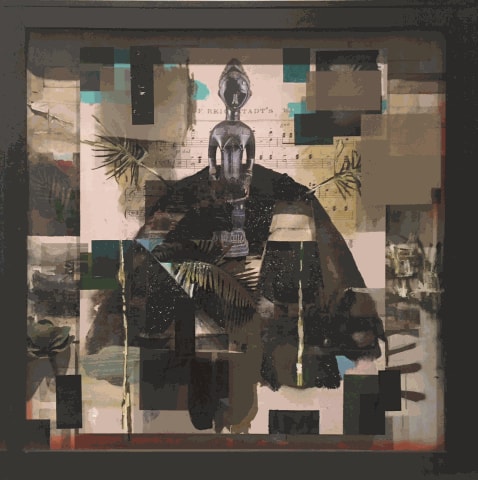Yet Bailey’s collages and installations were not directly inspired by the vast marsh. Indeed, they may owe more to that Cadillac.
That’s because Bailey is fascinated by the talismanic power of vintage objects. His Reston exhibition features several glass-doored cabinets full of such things, some of them handed down by relatives. The case that includes many family heirlooms, including his grandmother’s tintypes, “feels more like an altar,” Bailey said during a break from installing the show this spring.
Bailey builds his assemblages intuitively and leaves them open to interpretation. “I don’t want to get too locked down into making a statement,” he said. “If it doesn’t make sense, I’m cool with that.”
Statement-making or not, the context is clear: the African and African American experiences. The show’s centerpiece is a roiling sea of several thousand wooden piano keys, some with the plastic keytops still attached. The overlapping sticks suggest the action of waves or the debris left in the wake of a flood.
It could be the flood of history. A bust of a man’s head, covered in a glittery mix of black paint and white sand, pokes above wooden swells to memorialize the many subjugated Africans who didn’t survive the Middle Passage. The piece’s title is “Windward Coast — West Coast Slave Trade,” and the head was inspired by documentation in European museums of abuses in the Belgian-ruled Congo.
The artist has done versions of the installation in a half-dozen locations, from his home town to Senegal and Colombia. “Every time I do it, I do it a different way,” he said. This edition is just half the size of largest one.
Bailey acquired the piano keys — he has more than 400 sets of 88 each — from an Atlanta music shop that was disposing of them. “I didn’t know what I was going to do with them,” he admitted. Like so many of his ingredients, the keys have been around awhile. Some are dated, and the oldest says “1910.”
The keys signify Bailey’s love of music, which is evident in several of the show’s pieces. And because they’re fragments of a musical past that can be put together in a new way, they suggest hip-hop’s original scratch-and-chop aesthetic.
One early idea for the keys was as representations of DNA code. It’s hardly surprising that a man who resequences found objects to conjure history and culture would ponder genetics. One of the show’s pieces, a metal model for a larger sculpture, combines a sailing ship and an oar and is titled “Creole.” Several of the cabinets juxtapose African and European art and society.
“I’m made up of so many different kinds of people,” the artist said.
Although born in New Jersey, Bailey has spent most of his life in Atlanta, where he draws inspiration from the histories of the civil rights movement and the Civil War. He lives on land that was the site of skirmishes during that conflict, land that occasionally yields artifacts from it.
Even dirt and sand can imply people and places. The glimmering black grit employed in several of Bailey’s pieces was inspired by beaches in Jamaica, another crucial location in the history of the slave trade. A collage painting titled “Clotilde,” after the last ship known to have brought slaves from Africa to the United States, features a coating of sand-flecked ebony paint atop one of Georgia clay.
Two sculptural pieces have fewer layers — at least physically. “Blue Black” is a glass heart that leaks blue pigment onto a white wall, evoking water as well as indigo, the dye plant cultivated by slaves on Southern plantations. “Travel by Night” is an outsize lantern that recalls travel via the Underground Railroad.
One route on that path to freedom was through the Great Dismal Swamp, whose thickets also provided sanctuary to thousands of escaped slaves who lived there from around 1700 to the end of the Civil War. Their story is not told directly here, but then Bailey is not exactly a storyteller.
The artist combines things that have meaning for him. But he also likes to hear what the finished pieces mean to the people who view them. “I learn more from my work when the work is up,” he said, “than when I’m making it.”
Radcliffe Bailey: The Great Dismal Swamp
12001 Market St., Reston. 703-471-9242. restonarts.org.
Dates: Through August 18, 2017

